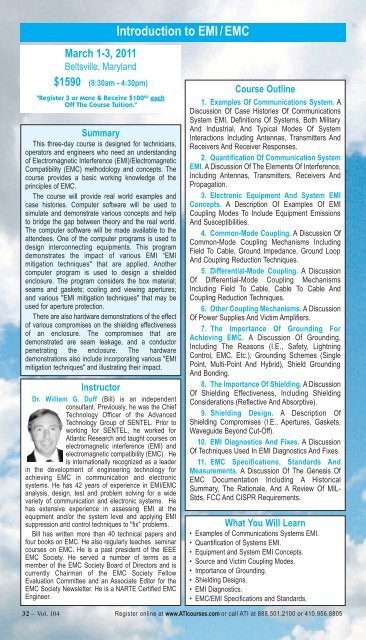Systems Engineering - ATI
Systems Engineering - ATI
Systems Engineering - ATI
You also want an ePaper? Increase the reach of your titles
YUMPU automatically turns print PDFs into web optimized ePapers that Google loves.
March 1-3, 2011<br />
Beltsville, Maryland<br />
$1590 (8:30am - 4:30pm)<br />
"Register 3 or More & Receive $100 00 each<br />
Off The Course Tuition."<br />
Summary<br />
This three-day course is designed for technicians,<br />
operators and engineers who need an understanding<br />
of Electromagnetic Interference (EMI)/Electromagnetic<br />
Compatibility (EMC) methodology and concepts. The<br />
course provides a basic working knowledge of the<br />
principles of EMC.<br />
The course will provide real world examples and<br />
case histories. Computer software will be used to<br />
simulate and demonstrate various concepts and help<br />
to bridge the gap between theory and the real world.<br />
The computer software will be made available to the<br />
attendees. One of the computer programs is used to<br />
design interconnecting equipments. This program<br />
demonstrates the impact of various EMI “EMI<br />
mitigation techniques" that are applied. Another<br />
computer program is used to design a shielded<br />
enclosure. The program considers the box material;<br />
seams and gaskets; cooling and viewing apertures;<br />
and various "EMI mitigation techniques" that may be<br />
used for aperture protection.<br />
There are also hardware demonstrations of the effect<br />
of various compromises on the shielding effectiveness<br />
of an enclosure. The compromises that are<br />
demonstrated are seam leakage, and a conductor<br />
penetrating the enclosure. The hardware<br />
demonstrations also include incorporating various "EMI<br />
mitigation techniques" and illustrating their impact.<br />
Instructor<br />
Dr. William G. Duff (Bill) is an independent<br />
consultant. Previously, he was the Chief<br />
Technology Officer of the Advanced<br />
Technology Group of SENTEL. Prior to<br />
working for SENTEL, he worked for<br />
Atlantic Research and taught courses on<br />
electromagnetic interference (EMI) and<br />
electromagnetic compatibility (EMC). He<br />
is internationally recognized as a leader<br />
in the development of engineering technology for<br />
achieving EMC in communication and electronic<br />
systems. He has 42 years of experience in EMI/EMC<br />
analysis, design, test and problem solving for a wide<br />
variety of communication and electronic systems. He<br />
has extensive experience in assessing EMI at the<br />
equipment and/or the system level and applying EMI<br />
suppression and control techniques to "fix" problems.<br />
Bill has written more than 40 technical papers and<br />
four books on EMC. He also regularly teaches seminar<br />
courses on EMC. He is a past president of the IEEE<br />
EMC Society. He served a number of terms as a<br />
member of the EMC Society Board of Directors and is<br />
currently Chairman of the EMC Society Fellow<br />
Evaluation Committee and an Associate Editor for the<br />
EMC Society Newsletter. He is a NARTE Certified EMC<br />
Engineer.<br />
Introduction to EMI / EMC<br />
Course Outline<br />
1. Examples Of Communications System. A<br />
Discussion Of Case Histories Of Communications<br />
System EMI, Definitions Of <strong>Systems</strong>, Both Military<br />
And Industrial, And Typical Modes Of System<br />
Interactions Including Antennas, Transmitters And<br />
Receivers And Receiver Responses.<br />
2. Quantification Of Communication System<br />
EMI. A Discussion Of The Elements Of Interference,<br />
Including Antennas, Transmitters, Receivers And<br />
Propagation.<br />
3. Electronic Equipment And System EMI<br />
Concepts. A Description Of Examples Of EMI<br />
Coupling Modes To Include Equipment Emissions<br />
And Susceptibilities.<br />
4. Common-Mode Coupling. A Discussion Of<br />
Common-Mode Coupling Mechanisms Including<br />
Field To Cable, Ground Impedance, Ground Loop<br />
And Coupling Reduction Techniques.<br />
5. Differential-Mode Coupling. A Discussion<br />
Of Differential-Mode Coupling Mechanisms<br />
Including Field To Cable, Cable To Cable And<br />
Coupling Reduction Techniques.<br />
6. Other Coupling Mechanisms. A Discussion<br />
Of Power Supplies And Victim Amplifiers.<br />
7. The Importance Of Grounding For<br />
Achieving EMC. A Discussion Of Grounding,<br />
Including The Reasons (I.E., Safety, Lightning<br />
Control, EMC, Etc.), Grounding Schemes (Single<br />
Point, Multi-Point And Hybrid), Shield Grounding<br />
And Bonding.<br />
8. The Importance Of Shielding. A Discussion<br />
Of Shielding Effectiveness, Including Shielding<br />
Considerations (Reflective And Absorptive).<br />
9. Shielding Design. A Description Of<br />
Shielding Compromises (I.E., Apertures, Gaskets,<br />
Waveguide Beyond Cut-Off).<br />
10. EMI Diagnostics And Fixes. A Discussion<br />
Of Techniques Used In EMI Diagnostics And Fixes.<br />
11. EMC Specifications, Standards And<br />
Measurements. A Discussion Of The Genesis Of<br />
EMC Documentation Including A Historical<br />
Summary, The Rationale, And A Review Of MIL-<br />
Stds, FCC And CISPR Requirements.<br />
What You Will Learn<br />
• Examples of Communications <strong>Systems</strong> EMI.<br />
• Quantification of <strong>Systems</strong> EMI.<br />
• Equipment and System EMI Concepts.<br />
• Source and Victim Coupling Modes.<br />
• Importance of Grounding.<br />
• Shielding Designs.<br />
• EMI Diagnostics.<br />
• EMC/EMI Specifications and Standards.<br />
32 – Vol. 104 Register online at www.<strong>ATI</strong>courses.com or call <strong>ATI</strong> at 888.501.2100 or 410.956.8805

















